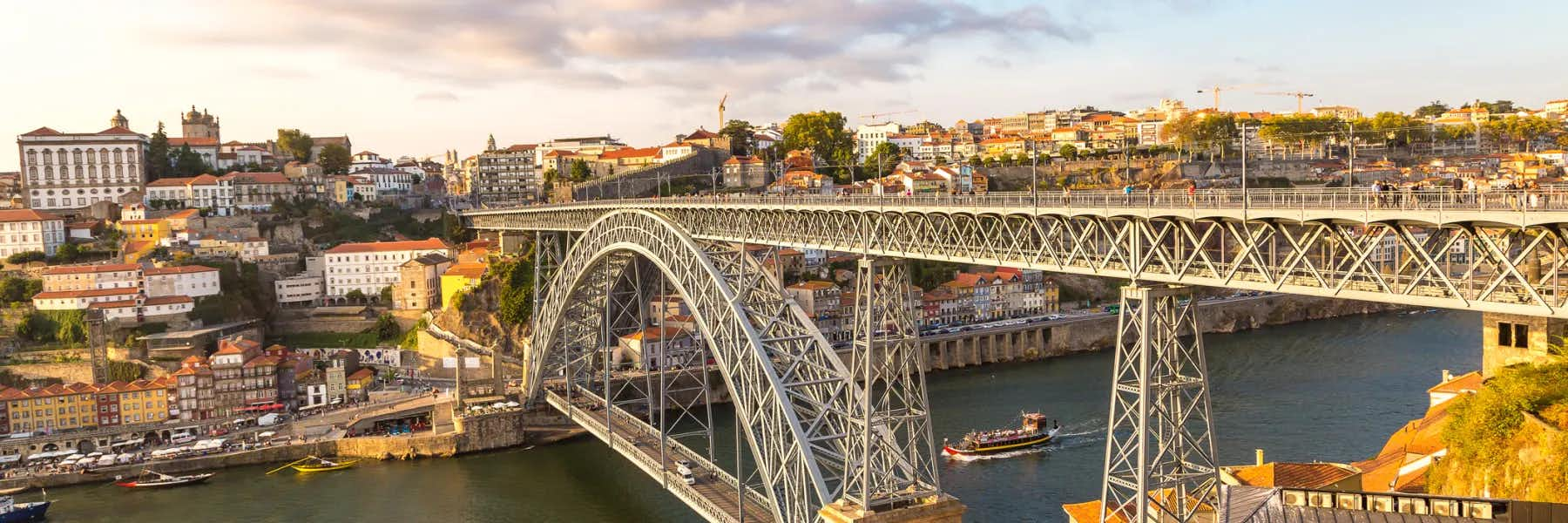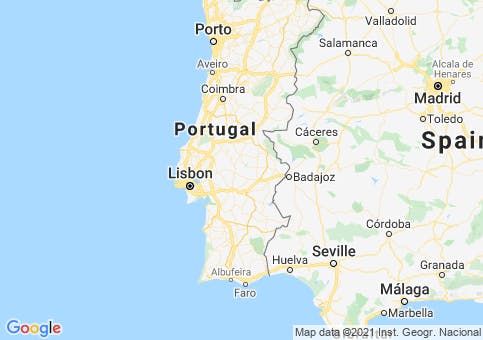Porto, the second largest metropolitan area in Portugal after Lisbon, is located on the Douro River where it flows into the Atlantic. The city is home less than 240,000 people in the city center (about 2.4 million in the greater metropolitan area) and has a small city’s feel and friendliness. But it’s also a thriving international business city, with many expats finding all the amenities they need, including an international airport.
Retire in Porto
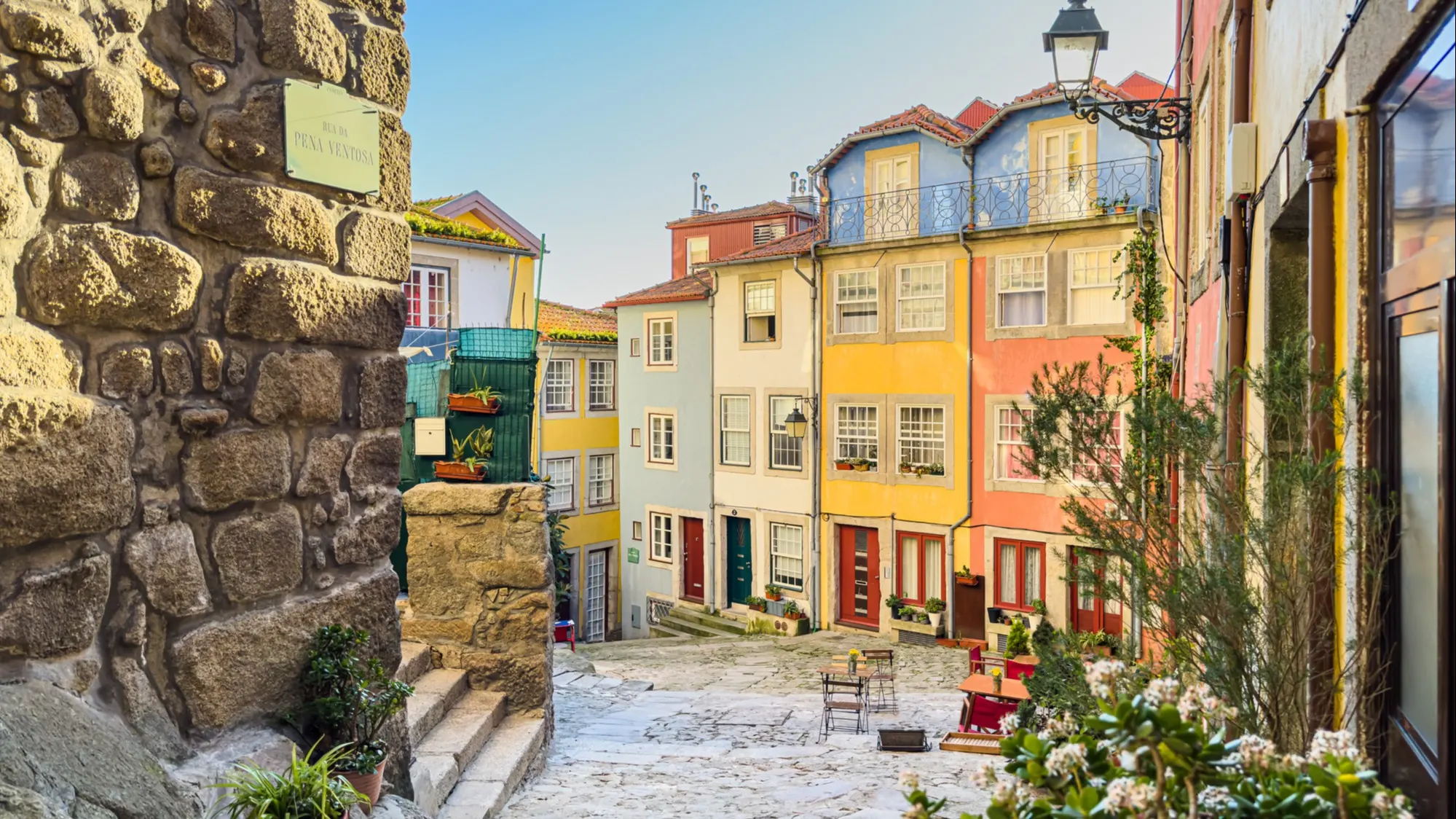
The richness of culture available makes the city an ideal place for retirement. You’ll be surrounded by elegant parks with fountains, statues, and exotic plants, leafy boulevards, and cobbled streets lined with historic buildings. Porto’s cool, mild, climate means temperature averages around 73 to 84F in the dry summer season, and 50 F in winter, which lasts from December through March and can be wet.
However, in Porto, there’s no need to own a car. There’s an extensive bus network and a tramway—the first on the Iberian Peninsula—using vintage cars, and the metro will take you to the golden sands of the Atlantic in just 15 minutes. But the town is best experienced on foot and its scenic riverfront provides the perfect backdrop for an anytime stroll.
Retiring in a city that boasts beautiful architecture creates a sense of perpetual vacation. One impressive edifice is the São Bento train station. The station, the oldest and most beautiful in Porto, was built on the site of a Benedictine monastery. The big draw is the panels comprised of 20,000 blue-and-white azulejo tiles, a glazed colored tile traditionally used in Portuguese buildings. Dating from 1905 to 1916, they are the work of famed craftsman Jorge Colaço.
Another example is the Cathedral, or Sé, dating from the 12th century. Fortress-like in design, its walls are also covered in azulejos. The Romanesque gem is where famed explorer Prince Henry the Navigator, known in Portugal as “Infante Dom Henrique”, was baptized.
The Church of São Francisco, Porto’s most important Gothic monument, is another impressive site. It’s 17th and 18th century Baroque interior, is filled with spectacular gilt-covered wood carvings and features a polychromed altarpiece from 1718 depicting “The Tree of Jesse”
Speaking of lovely buildings, Café Majestic, opened in 1921, is considered one of the most exquisite cafés in the world. With a long tradition as a gathering place for the literary, artistic, and political elites, you will surely sense the glamour of that past when you pass through its Art Nouveau doors. The restaurant is located on Rua Catarina, a street that also boasts plenty of stores for browsing and shopping.
Rua Santa Catarina is the main shopping street in Porto. Here, Zara, H&M, and other trendy stores mingle with fine jewelers and souvenir shops to offer a satisfying variety for every taste. Part of the street is closed off to traffic, so you can stroll, dine, drink, and people-watch at your leisure.
Lifestyle in Porto
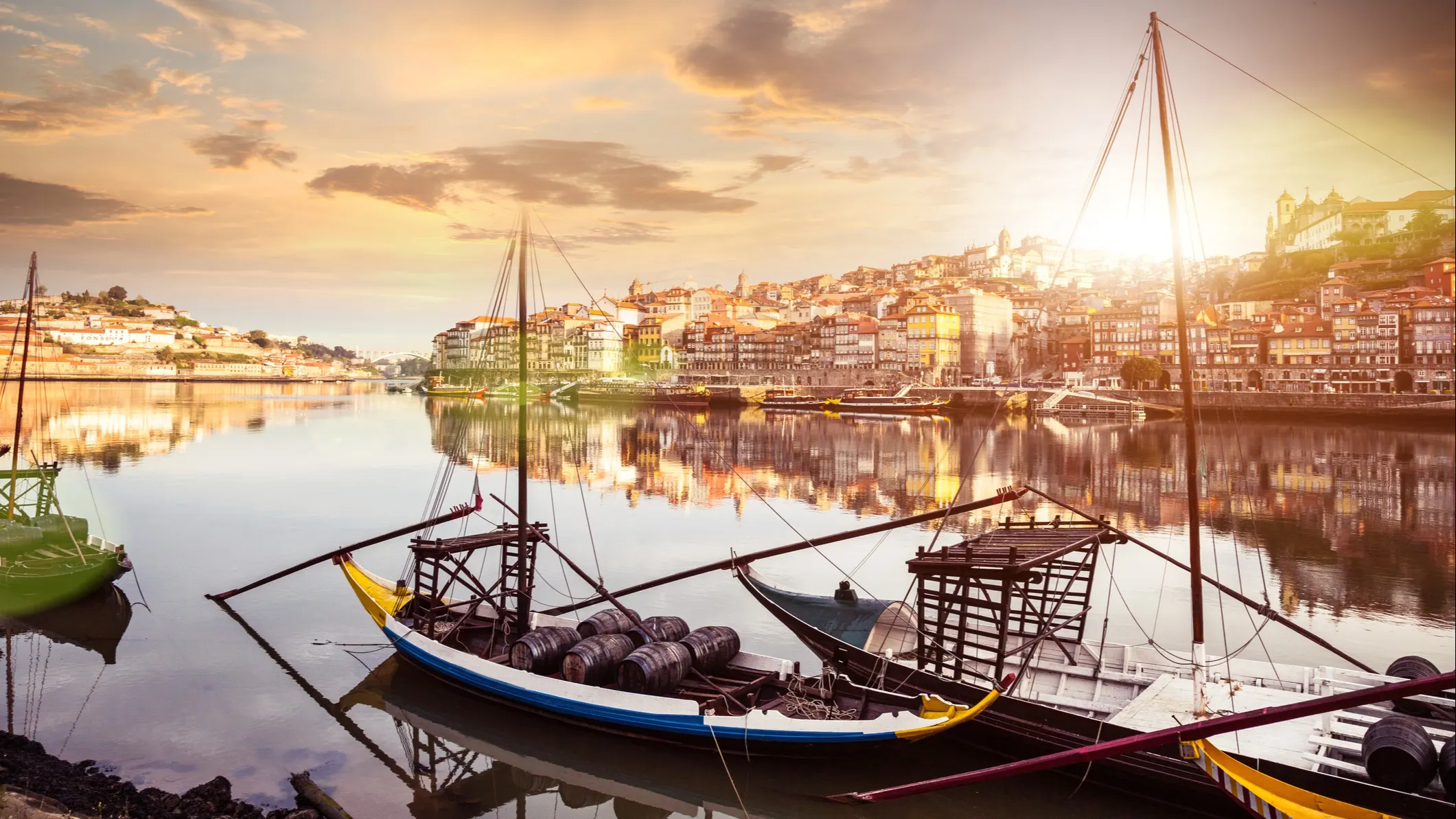
Besides history and culture, this is a city where food and wine are inextricably interwoven into its residents’ lifestyle.
Perhaps the most iconic dish in the north of Portugal is francesinha, literally, “Little Frenchy.” Tradition says it was invented in the 1960s by Daniel David Silva, who had lived in France, basing his creation on the classic croque monsieur, a toasted ham and cheese sandwich with béchamel sauce. A daunting concoction, the francesinha is made of bread, wet-cured ham, linguiça, fresh sausage, and steak or roasted meat, all topped with melted cheese and a hot thick tomato and beer sauce. Sometimes an egg is thrown in for good measure. Silva is said to have invented this dish while working at A Regaleira, a Porto restaurant.
Porto is of course famous for its fortified wine of the same name…port. Walk across the Dom Luís I Bridge over the Douro River to Vila Nova de Gaia, and dip into one of the many wine cellars or caves. There you can take a tour and participate in a tasting for about $6. Popular choices are Graham’s, Taylor’s, Sandeman, and Quinta de Noval. Another good option is Cálem, all the easier to visit as it’s the first place you’ll encounter when you exit the bridge onto Cais de Gaia. One lesser-known house is Vasconcellos, family-owned and in operation since the 18th century. Some houses provide fado, the country’s iconic song accompanied by stringed instruments, for your sipping pleasure.
Porto loves to party. In midsummer, you can catch the Festa de São João, the Festival of Saint John. A tradition dating back more than six centuries, it is the city’s most important celebration. Beginning in the afternoon of June 23, thousands of people flood the streets of both the city center and small neighborhoods to celebrate.
Originally a tribute to John the Baptist, during the 19th century the populace introduced activities with roots in pagan courtship rituals. Festival-goers pelt each other with garlic flowers and soft plastic hammers, jump over flames, and eat boiled eggs and sardines (sardinhas) grilled on outdoor barbecues. Midnight brings a fireworks display and dancing continues into the wee hours of the morning.
Get Your Free Portugal Report Today!
Get Your Free Portugal Report Today!
Discover why we love a slower pace of life in Portugal and info on other European countries in our daily postcard e-letter. Simply enter your email address below and we’ll send you a FREE REPORT – Explore the Old World in Laidback Portugal.

By submitting your email address, you will receive a free subscription to IL Postcards and special offers from International Living and our affiliates. You can unsubscribe at any time, and we encourage you to read more about our Privacy Policy.
Cost of Living in Porto
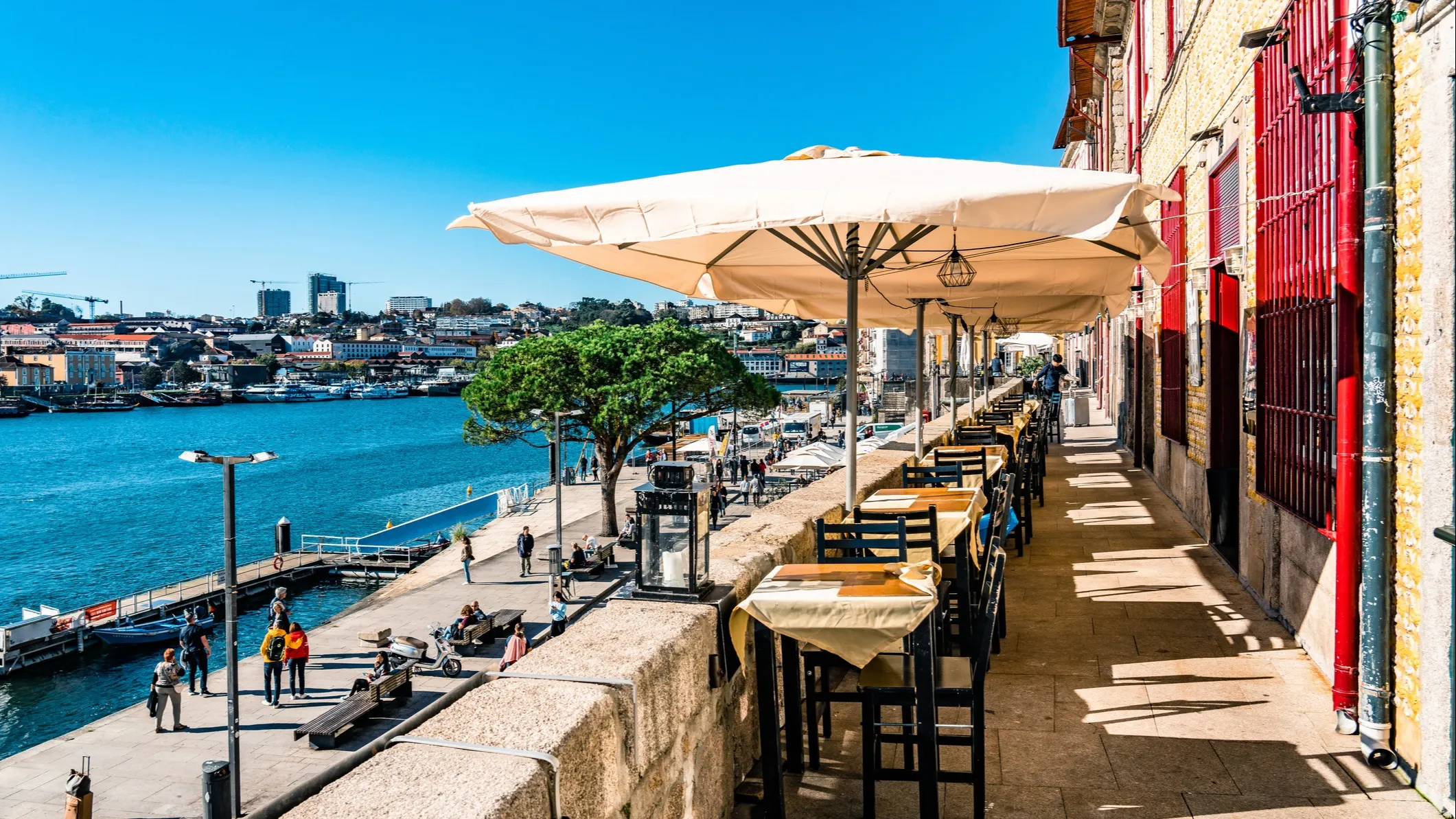
For all Porto’s natural and architectural beauty, fine food and wine, and pleasurable pastimes, it’s surprisingly affordable to live here. A cup of coffee in a café is a dollar or less, fresh fruit $1 per pound, and a three-course lunch for two including wine at a mid-range restaurant will cost you just $30. Senior discounts are offered in many museums, trains and other points of interest. Here’s some useful monthly cost of living information, to help give you an idea of what you might expect to spend living in Porto:
| Item | Cost |
|---|---|
| Rent (one- bedroom apartment) | $850 |
| Utilities (Gas and electric, depending on season) | $150 |
| Water | $50 |
| Internet/Telephone/Cell phones (x2)/Cable (package) | $100 |
| Maid (3 hours bi-weekly) | $50 |
| Groceries | $500 |
| Transportation: Mass transit/Tank of gas | $100 |
| Dining and entertainment | $300 |
| Monthly Total: | $2,100 |
Many European cities have been sought out by expats from the U.S., Canada, and Australia in recent years. What Porto offers is an enchanting combination of Old World charm and First-World convenience wrapped in a consummately affordable and attractive package.
Video Tour of Porto
24 Hours in Porto: What to See, Do, and Eat

By Jeff D. Opdyke
There is a notion, afoot for years now, that pastries for breakfast are death on a plate. Dear, Lord: Please never allow this madness to migrate to Portugal. By which I mean, I woke up in Porto, starving, and immediately set out for the Majestic Café to begin my 24 hours in Portugal’s second city.
Most cities have their unique charm. Porto’s is that it is a less-polished, quieter, more Bohemian and touristically less-mature city than its big brother to the south, Lisbon. Yet Porto’s picturesque location along the Douro River, its compact central tourist area, and the colorful tile work and pastel rainbow that exploded across the ancient buildings means Porto is a great city to spend a day wandering and eating… and wandering some more.
And, as every day should by law, it starts with…
Breakfast at the Majestic Café
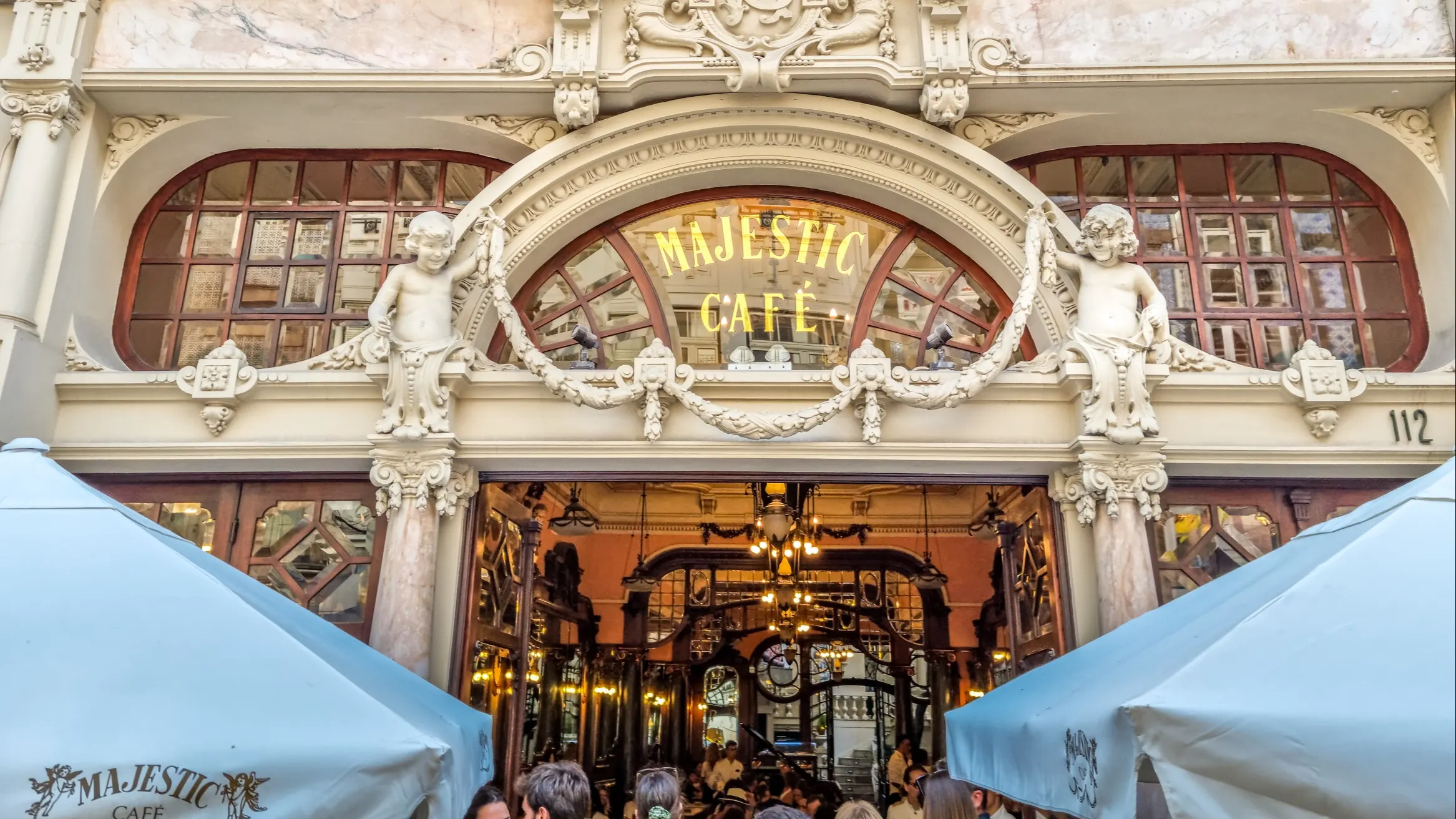
Few Belle Epoque eateries evoke an era as much as the Majestic. Built in 1921, this café in the center of Porto is the place for a languorous breakfast before the day’s walking commences. Sure, you can order a full plate of food, but why? All one really needs to gather the morning’s necessary fuel (before what will be a calorie parade at lunch) is a velvety tart known as pastel de nata—a couple of bites of egg-custard in a pastry shell, dusted with cinnamon. Pair it with an um galão directo (a milk-and-coffee drink with an added shot of espresso) and this is the true breakfast of champions, or at least those trying to win the game of life by experiencing some of the best of what every culture offers.
You can find pastel de nata all over Porto. But again, why? The smell of old leather. The wood. The glass and mirrors. The high ceilings and plaster frieze. Stepping into the Majestic is like stepping into 1920s Paris. As much as this is about pastel de nata for breakfast, it’s also about starting your day with a sense of history and elegance.
Get Your Free Portugal Report Today!
Get Your Free Portugal Report Today!
Discover why we love a slower pace of life in Portugal and info on other European countries in our daily postcard e-letter. Simply enter your email address below and we’ll send you a FREE REPORT – Explore the Old World in Laidback Portugal.

By submitting your email address, you will receive a free subscription to IL Postcards and special offers from International Living and our affiliates. You can unsubscribe at any time, and we encourage you to read more about our Privacy Policy.
Wander … Just Wander
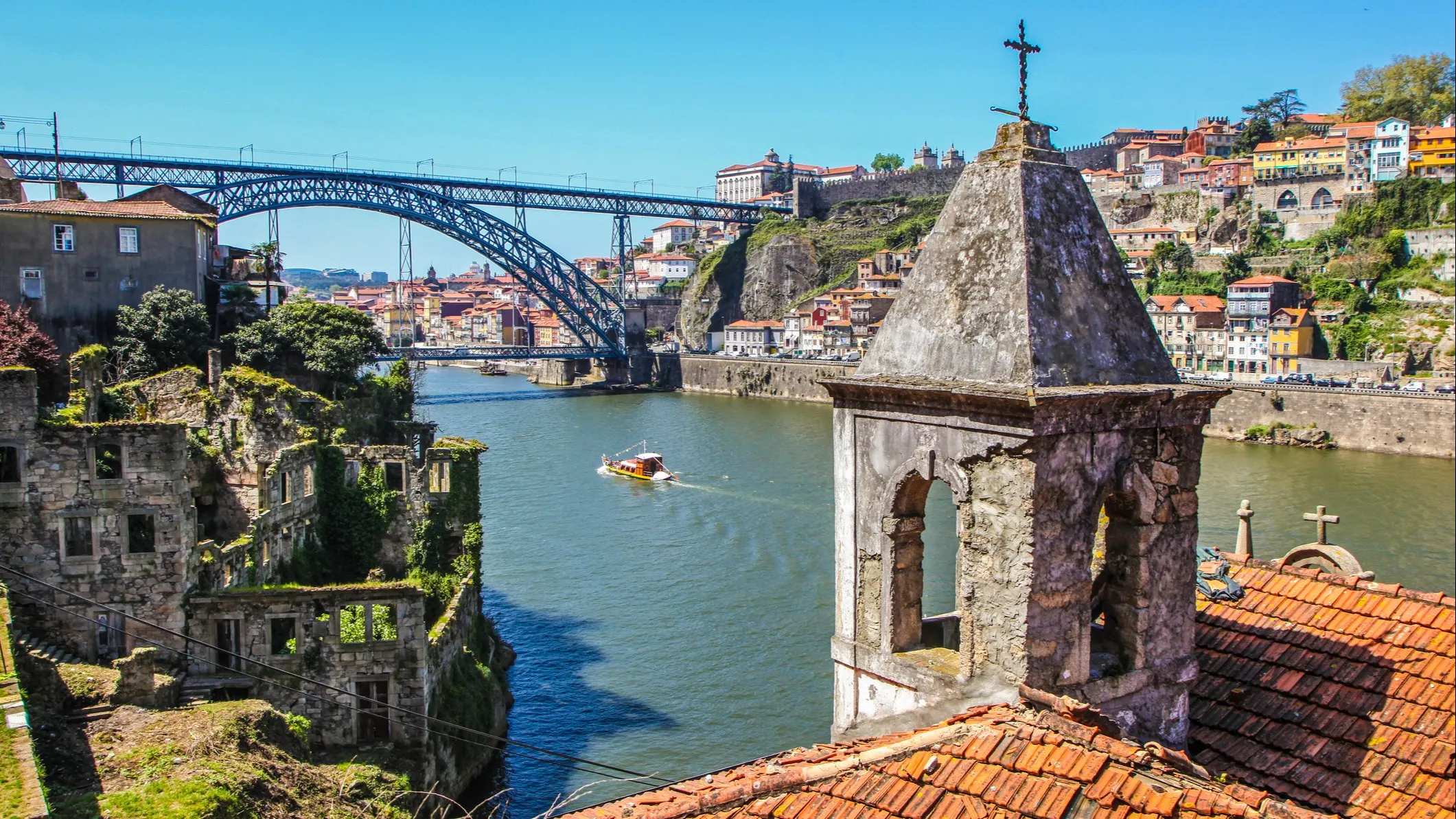
Porto is a beautiful city in perfect disrepair. It’s like seeing an elderly person and instantly knowing that, back in the day, they were an elegant stunner. That’s Porto. And the best way to experience her charm is to wander her streets aimlessly. Slip into the various churches you’ll inevitably pass, including the Sé do Porto, the main cathedral begun in the 12th century. Stroll the gardens. Climb the stairs through the small alleys you’ll find; you’ll often end up in a wondrous spot with a Kodak-moment view. Walk along the Douro. Hike the 225 steps of the Baroque-era Clerigos Tower. Pop into shops and outdoor, neighborhood markets. Your legs will scream; this is a hilly town. But the experience won’t leave you disappointed.
Lunch with Locals on a Porto Belly Bomb
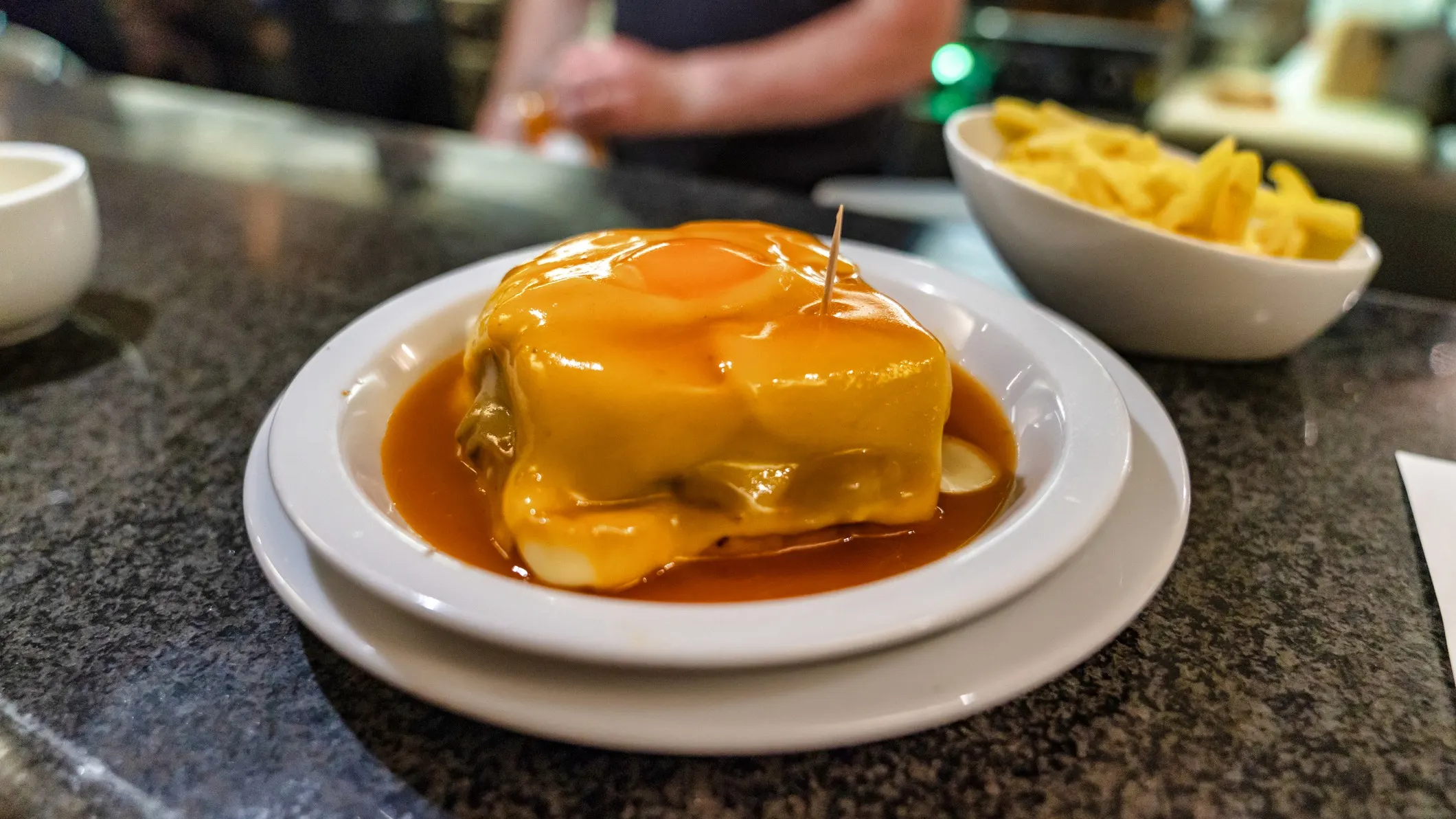
I am not going to tell you that the francesinha is the world’s best sandwich—not when our world is filled with sandwiches such as Vietnam’s bahn mi, Uruguay’s chivito, and a hot, debris po-boy from a hole-in-the-wall in the New Orleans French Quarter. But I am going to tell you that, unless you’re a vegetarian, you cannot leave Porto without the experience of a francesinha (sounds like: fracis-zeenya).
This obscene bastardization of France’s famous croque-monsieur marries ham, sausage, and a thin steak between fat slices of bread, that’s then swaddled in a blanket of melted cheese, bathing in a tomato-beer sauce, all gussied up with a fried egg on top. Thus, you now see the wisdom of my proposal that you subsist on but a single pastel de nata for breakfast.
You’ll find many eateries with francesinha on the menu. For me, it was O Golfinho, located on a downtown side-street, which mean it’s off the typical tourist trail. This is one of the best places to find the calorie monster. But arrive early. O Golfinho opens at noon and it’s a thin, shotgun-house of a restaurant that seats less than 30 people—and those 30 people (and more) routinely show up for lunch, packing the place. Arrive early; leave stuffed.
Walk across the Ponte De Dom Luis I.
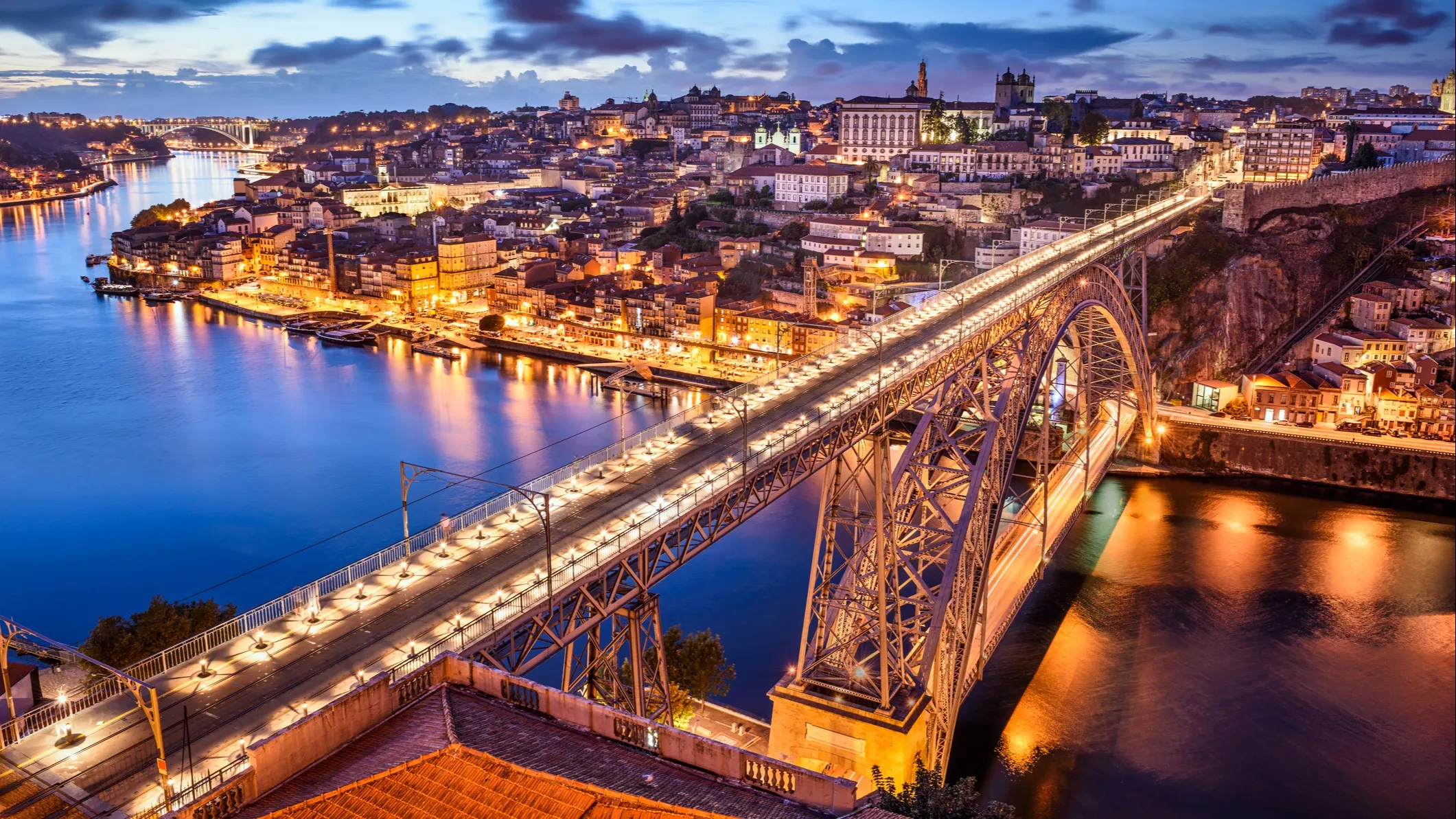
You will, of course, demand sleep after an O Golfinho outing. Resist the Sandman’s call. Instead, it’s time to burn off some of that francesinha. For the same reason walking across the Brooklyn Bridge is a thing, so, too, is trekking Porto’s iconic and scenic Dom Luis bridge spanning the Douro River. Here you find one of the postcard views of Porto.
There are two ways to do this, so do both. This is a double-deck bridge: take the lower bridge on your way across, and the upper bridge on your way back into the city (or vice versa). Up top, you will share the bridge with Porto’s modern metro rail. Down below, you’ll share it with cars. Either way, you’ll have beautiful views of the city.
Don’t Drink the Water! (Drink the Port)
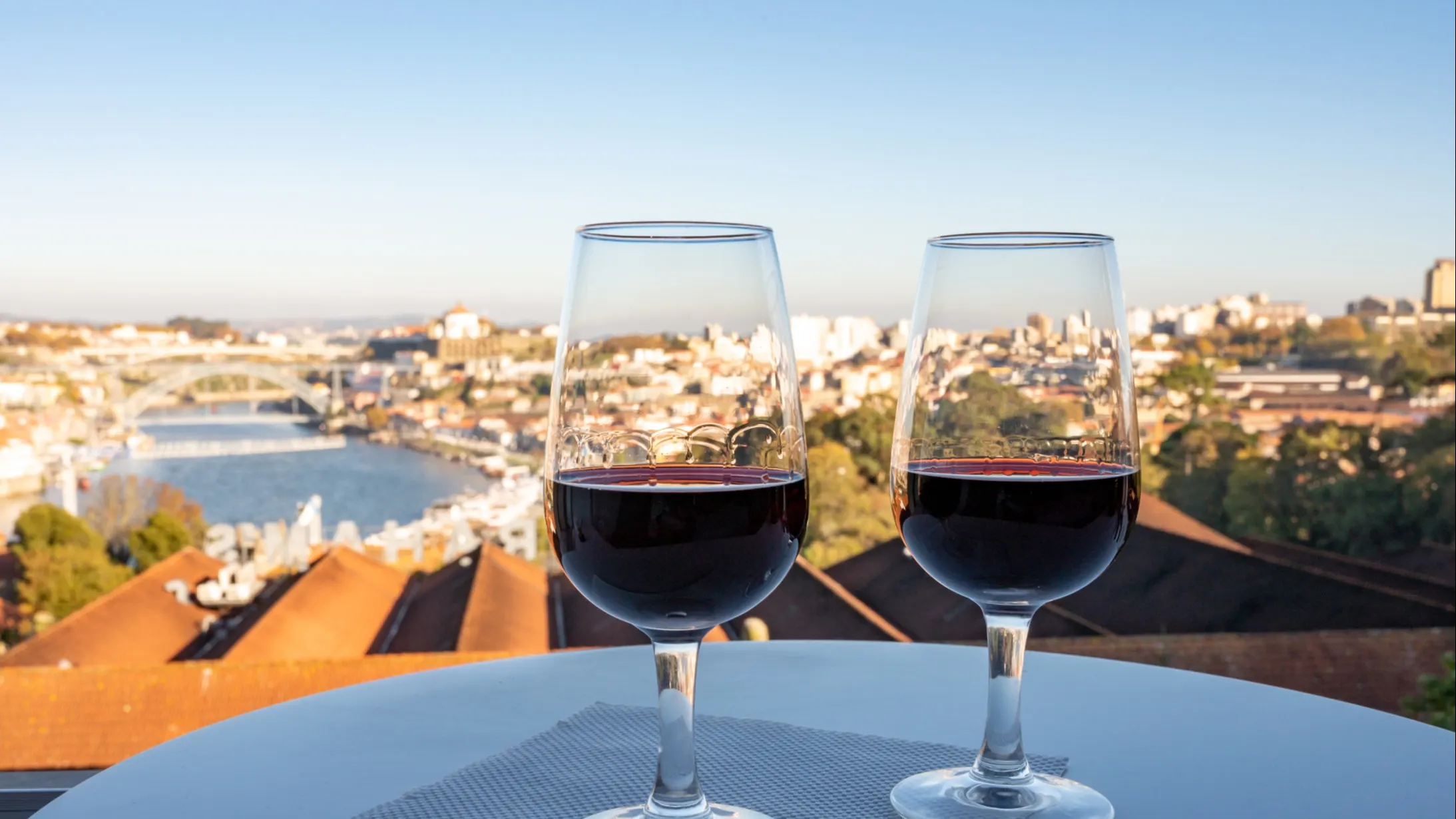
Port wine was born in Porto. And the city is home to famous port cellars including Sandeman and Taylor. Just across the Dom Luis bridge, take a right—and in less than 10 minutes you’re at Sandeman, where you can tour the cellars and taste the end product.
Afterwards, amble back toward the bridge, aiming for the upper deck. When you reach the metro tracks, hang a right (away from the river) and walk a few blocks. You will come to the entrance, on the left, to the Serra do Pilar Monastery, where you’ll find a small park with one of the best views of Porto and the Dom Luis Bridge.
Tapas, Portuguese-style
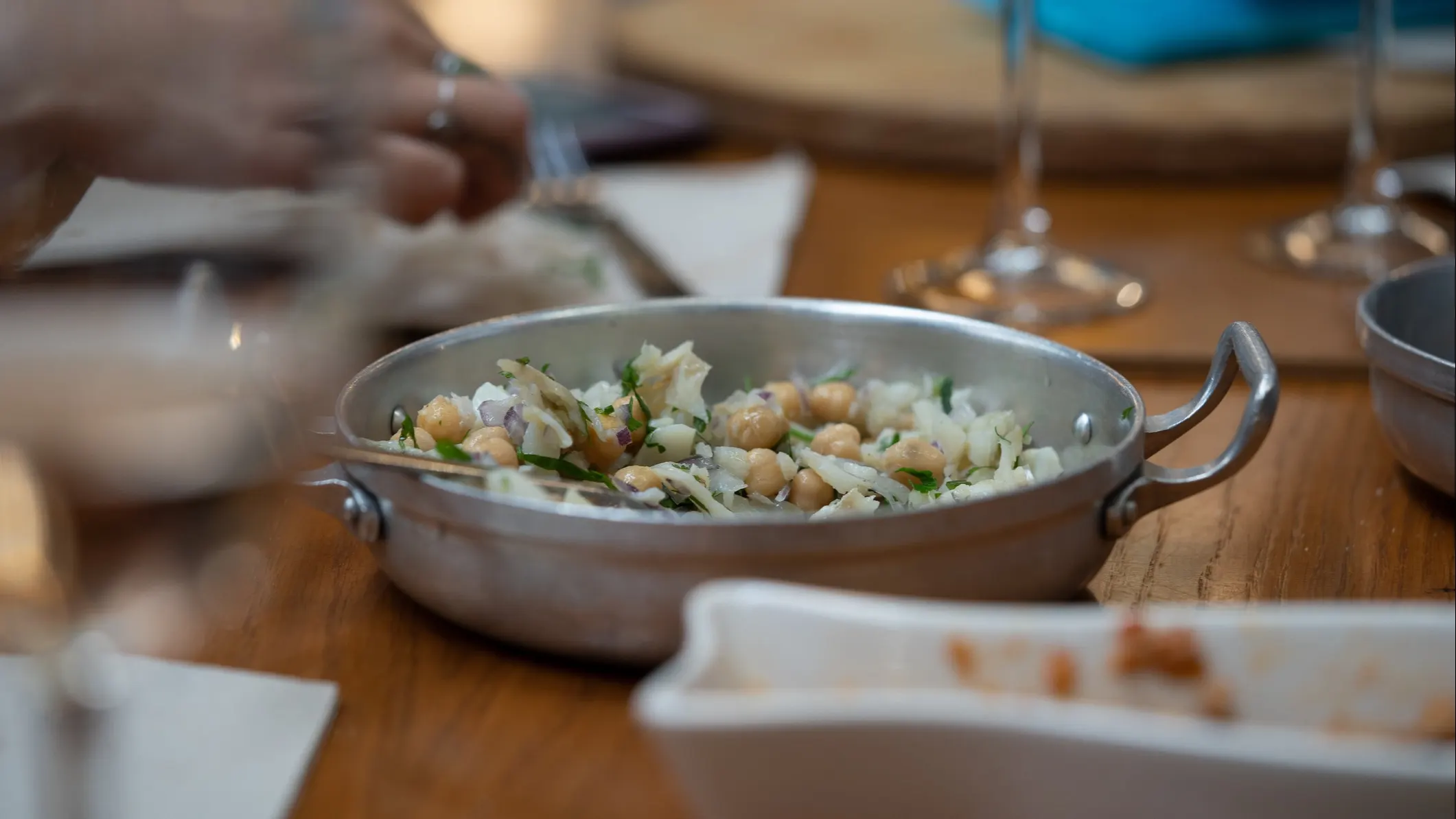
Spain has its tapas, Portugal has petiscos. Lots of spots claim they’re the best at petiscos in Porto—and, really, who can say? For me, I’d argue Alfredo Portista is one of the tops. It’s a tasca, the British equivalent of a neighborhood pub, and it looks the part. Don’t expect Michelin-star ambiance. Do expect lots of memorabilia on the walls dedicated, shrine-like, to the local soccer club, FC Porto, and lots of locals jabbering about soccer and politics. The food here is fresh, flavorful and, best of all, dishes are generally between $1 and $3. But the doors shut by about 8:30 p.m. —allowing you to get back to your hotel early and pass out from all the walking and eating in Porto.
The Best Things to Do in Porto
By Cindy Sheahan
Porto has something for everyone—from touring the local football stadium to handmade azulejo tile workshops; from visiting the soaring Cathedral to finding the perfect brunch spot on Rua de Cedofeita, Porto is a delight.
Here are some of the most interesting, unusual, unique, and fun things to put on your list of “must-do” experiences when in this beautiful city.
Walking Tours
Although Porto is a world-class city with a symphony orchestra, a lovely art museum, lush botanic gardens, a military museum, the famous and acoustically perfect Casa de Musica concert hall, ornate churches galore, and a stunning cathedral—all of which deserve your time and attention—it’s the kind of city that asks to be enjoyed slowly… by walking.
The best way to do this is to take a walking tour. They’re a surefire way to see a city from the ground up, learn the history, and explore the important areas of town. You’ll find knowledgeable and friendly guides at Porto Walkers, who will take you around the city center, street art tours, a pub crawl, or port wine tours across the Douro River in Vila Nova de Gaia.
In addition to a walking tour, you’ll want to wander down Rua Santa Caterina, Rua das Flores, Cedofeita, and Miguel Bombarda Streets. These pedestrian-friendly streets have a plethora of fun restaurants, boutiques, jewelry stores, art galleries, weekly flea markets, and craft vendors. Feel free to stop to rest your feet, order a coffee or a glass of local Douro wine for a few euros and enjoy the game of people-watching.
Get Your Free Portugal Report Today!
Get Your Free Portugal Report Today!
Discover why we love a slower pace of life in Portugal and info on other European countries in our daily postcard e-letter. Simply enter your email address below and we’ll send you a FREE REPORT – Explore the Old World in Laidback Portugal.

By submitting your email address, you will receive a free subscription to IL Postcards and special offers from International Living and our affiliates. You can unsubscribe at any time, and we encourage you to read more about our Privacy Policy.
Visit the Bolhao Marketplace
Don’t miss the Bolhao Mercado! You’ll enjoy this recently renovated neoclassical building with soaring ceilings and tidy stalls. Grab a glass of vinho verde (Portugal’s sparkling fresh “green” wine) and wander about, admiring (and purchasing!) fresh fruits and vegetables, freshly squeezed juices, and local wines. There’s also a bounty of sausages, cheeses, freshly caught fish, beautiful fragrant flowers, and colorful tins of locally produced sardines stacked high.
Visit Porto’s Historical Sights
Some of the important, 12th century beautiful, and historic places that are a “must-see” include the gorgeous and impressive Palacio da Bolsa, the Clerigos Tower (the laser light show, “Spiritus”, inside the church is absolutely amazing!) and a visit to the Se—Porto’s cathedral built in the with the beautiful rose window and of course, stunning azulejo tiles throughout. Amble across the iconic Dom Luis I bridge at sunset to sit in a café along the river and enjoy some petiscos (appetizers) and a glass of wine from the nearby Douro Valley.
While sipping, you can bask in the waning sunset, as it bathes the ancient riverfront Ribeira—a UNESCO World Heritage neighborhood—in inimitable golden light for a perfect photo op.
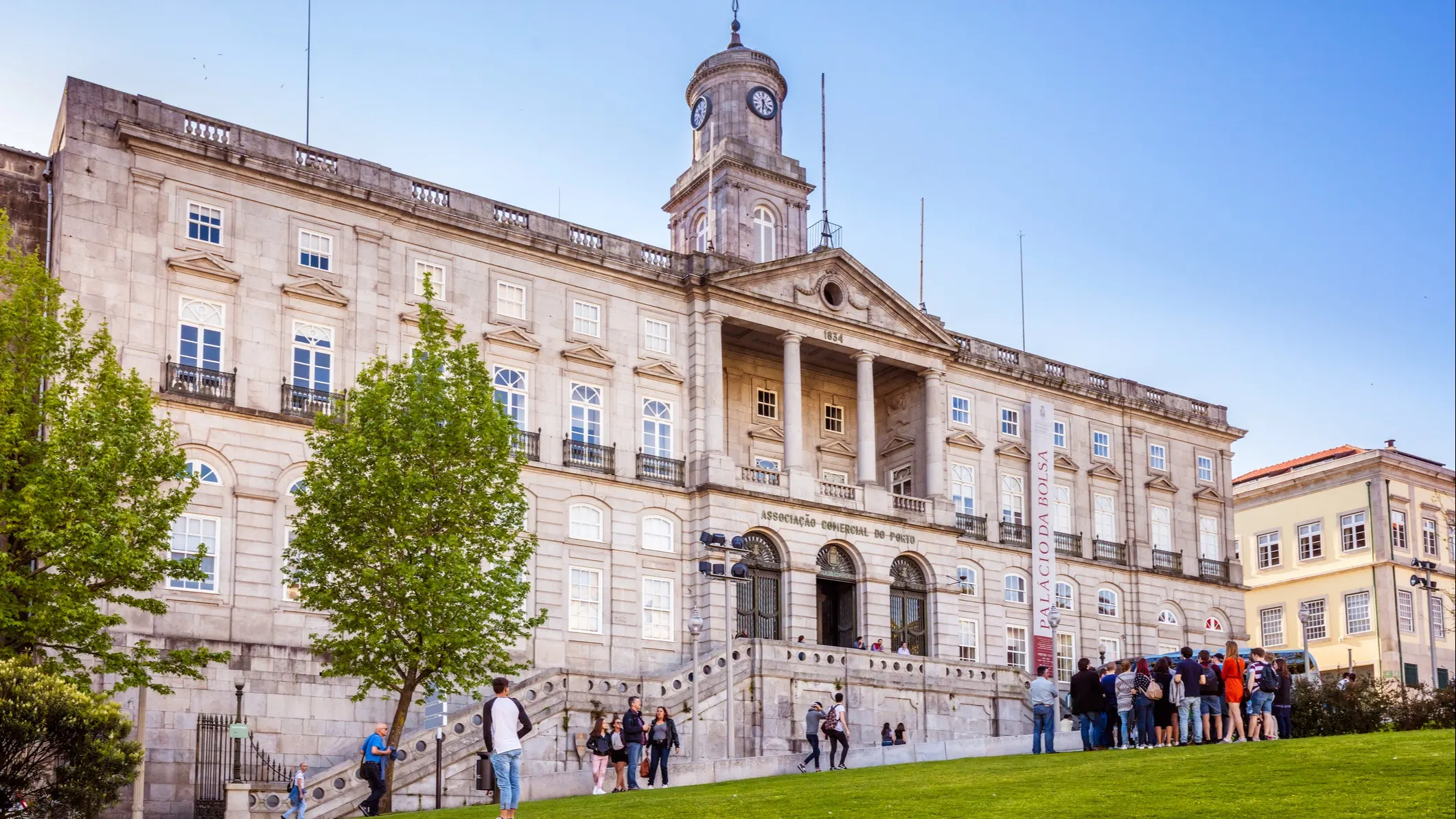
Azulejo Tile Workshop
Speaking of azulejo tiles… if you’d like to learn more about them and make your own? If so, make reservations for a session at the Gazete Azulejos Studio. This workshop is run by passionate tile enthusiasts who want to share their love and knowledge of these tiles and will assist you in making two azulejos for you to keep—a perfect souvenir of your time in Oporto!
Go to a Porto FC Soccer Game
Are you a soccer fan? Porto has its own professional (and very accomplished) football team and stadium. You can book a tour of Estadio Dragao (Dragon Stadium) which is on the metro and easy to get to. There’s a Porto FC (Football Club) Museum at the Stadium with trophies and memorabilia, interactive displays, an audio tour, and a guided tour of the stadium itself.
Enjoy a Port Tasting
Of course, no visit to Porto could be complete without a port tasting… or two! Cross the Dom Luis I bridge and stop in for a tour and tasting at one of the famous English port houses such as Sandeman’s, Cockburn’s, Ferreira, or Graham’s. Reservations suggested.

Take a Day Trip from Porto
Looking for something a bit different nearby? Hop on the #500 double-decker city bus (grab a window seat on the upper level of the bus for some amazing views!) or take the metro and head to Matosinhos, a village on the Atlantic coast around 13 km from the Sao Bento Train Station (and don’t miss the stunning display of over 22,000 azulejo tiles inside the train station, depicting important scenes in Portugal’s history).
Get there in the morning to experience the Mercado Municipal—the fish and produce market. Fresh fish of all shapes and sizes, live rabbits and chickens, fresh fruits and vegetables, jams and honey, souvenirs, local cheeses and sausages, and restaurants serving local meals—or purchase fish from the many vendors and have one of the restaurants cook it for you right on the spot!
After you’ve explored the Mercado, take a very charming and interesting tour of the Pinhais Cannery and visit the factory to see how sardines are sorted, cleaned, and processed—and enjoy a tasty (very large!) sample of sardines at the end of your tour. (Reservations required!)
Porto has something for everyone—from touring the local football stadium to handmade azulejo tile workshops; from visiting the soaring Cathedral to finding the perfect brunch spot on Rua de Cedofeita, Porto is a delight.
5 Reasons to Move to Porto
By Cindy Sheahan
If you’re not convinced yet, here are six reasons to consider moving to Porto. Voted the Best European Destination in 2012, 2014, and 2017, you’ll see why after living here for a bit!
An Architectural Beauty
Porto is an exceptionally walkable city and wandering the city streets provides an enthralling architectural tour de force—meandering city streets give way at almost every turn to grand buildings, new and old, adorned in azulejo tiles. Many churches are decorated in these iconic blue and white Portuguese tiles, and the famous Sao Bento Train Station is home to over 20,000 of these beautiful tiles!
Classic red tile roofs on the homes cascade down the hills of Porto, the black and white calcada (cobblestone) streets laid out in mesmerizing patterns. You’ll find deep history around every corner, with statues and plaques in plazas and parks commemorating the many fascinating events that have taken place over the millennia in this charming, resilient city.
A Gastronomic Haven
Porto boasts an abundance of high-quality restaurants offering a worldly array of cuisines—Thai, Vietnamese, Italian, French, Brazilian, and more! There are 23 Michelin-starred options, top-notch fresh seafood joints, and delicious steakhouses as well.
Of course, there are traditional Portuguese restaurants as well! You can get bacalhau (codfish, the national dish) which the Portuguese proudly claim can be served over 300 different ways. You’re spoilt for choice when it comes to delicious sandwiches, like the bifana (roasted pork with melty Serra de Estrela cheese from the mountains piled on a crusty roll), the infamous Francesinha sandwich. You could also opt for a prato do dia (plate of the day) at any local neighborhood tasca (tavern) or café for seven to nine euro, or delicious tripas a moda do Porto (Porto residents are referred to as tripieros because of this delicious tripe dish!)
And speaking of restaurants, Porto offers a casual café culture. There are hundreds of restaurants providing tables and chairs “al fresco” so you can order a coffee with a pastel de nata (the creamy custard tart famous here in Portugal), a chilled glass of vinho verde, or a specialty cocktail like a Porto Tonico. You can sit and sip, and watch the world go by. You can stay as long as you’d like—you’ll even have to ask for your bill (just say “a conta, por favor”) when you’re ready to go, as they’re in no hurry for you to leave. It’s delightful!
Fresh and Inexpensive Groceries
If you’re in the mood for a home-cooked meal, you’ll find charming neighborhood produce markets on the corner selling fruits and vegetables from Portugal, Spain, and beyond. The list is seemingly endless: fresh figs, shiny orange persimmons from Valencia, Spain, juicy maracuja (passionfruit) from the Azores, pumpkins and potatoes, aubergines (eggplants), Sweet small bananas flown in from the Portuguese island of Madeira. Don’t forget to pick up some delicious olives in green, black and “mixta” (a mix of green and black) in buckets—use the ladle to fill up your own container or a plastic baggie! Sold by the kilo, the variety is vast and the prices are very affordable!
Chicken, beef and pork can be found at the talhos (butcher) in every neighborhood. Local cheeses, sausage and fish, olive oil, fresh bread, and sometimes wine are available at these small markets and of course, everything can be found in the major supermarkets (Continente, Lidl, Pingo Doce, or Auchan for example) as well.
And let’s not forget delicious local wine that is inexpensive and amazing! There’s the Douro Region for incredible wines and port nearby, as well as wines from the Beira, Alentejo, and other regions in Portugal, supplying an unending variety of Portuguese wines.
Get Your Free Portugal Report Today!
Get Your Free Portugal Report Today!
Discover why we love a slower pace of life in Portugal and info on other European countries in our daily postcard e-letter. Simply enter your email address below and we’ll send you a FREE REPORT – Explore the Old World in Laidback Portugal.

By submitting your email address, you will receive a free subscription to IL Postcards and special offers from International Living and our affiliates. You can unsubscribe at any time, and we encourage you to read more about our Privacy Policy.
Public Transportation
You won’t need a car in Porto as the public transportation is wonderful! The metro system is inexpensive and reliable, and there are city buses galore to take you wherever the metro can’t. In addition, there are private bus companies offering routes throughout Portugal and into Spain—economic, clean, on time, and with bathrooms onboard! If you need a taxi, there are taxis or Uber, and many people use an app called Bolt that is similar to Uber, for low-priced rides.
And let’s not forget the train! Porto has two important train stations—Sao Bento in the center of Porto, and Campagna located a few kilometers east of the city center. You can take the train to the Douro Valley and visit dozens of wineries. Or hop on the train to Coimbra and listen to fado. Take a ride to Vila de Conde for the weekly market, or to Braga for the many festivals. It’s easy to get to Aveiro to see the canals… The trains are inexpensive, on time, and easy to use.
It’s so incredibly convenient to also have an international airport in Porto! Located right on the metro line, it’s quick and easy to get to from downtown Porto—around 30 minutes on public transport! Although not an overly large airport, OPO has flights to everywhere in Europe with Ryanair, EasyJet and other local economy airlines, as well as offering longer distance flights via TAP (Portugal’s airline), United, Lufthansa, Turkish Air, and more.
Beaches
If you’re a beach person, Porto won’t disappoint. Head over to the neighboring town of Matosinhos to catch some sunshine at the ever-popular Leca da Palmeira Beach, or pop over to Foz de Douro and relax in the sands of Gondarem Beach.
If you’re into surfing or just want to give it a try, there are surf schools and rental shacks along the shore where you can get equipment to use for the day inexpensively. Additionally, you can cross the Douro River and find some of Northern Portugal’s best stretches of sand on “the Gaia side” (Vila Nova de Gaia, the city across the bridges from Porto). Here you’ll find Aguda Beach or Canide Sul. Snack bars serving petiscos (appetizer snacks) and ice-cold drinks will keep you from getting hungry while you’re out enjoying the waves of the Atlantic.
These, and many more reasons such as a local football team, concerts, and art, parks and festivals, are why living in Porto is truly a special, unique, and lovely treat.
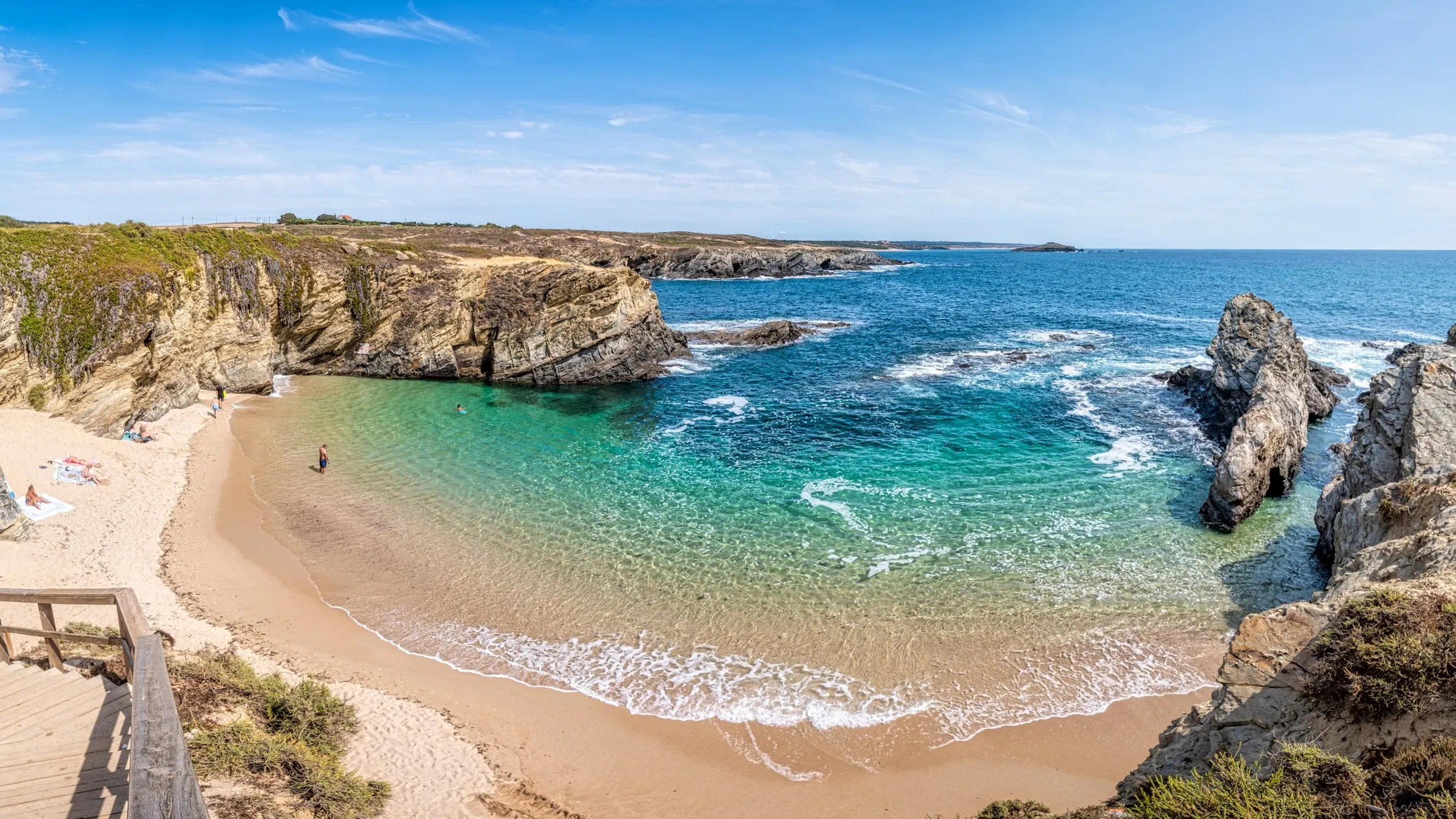
Guide to the Neighborhoods of Porto
By Cindy Sheahan
So, you’ve decided to move to Porto! Tudo bem! (“All right!”) You won’t be disappointed—Porto is a lovely, bustling, yet relaxed city, boasting a great restaurant scene, live music, its own football team ,and an architectural presence to make your heart sing. But where should you move? Which neighborhood would work for you?
Here are a few options for you to consider—some of the more popular choices for incoming folks to find an apartment to rent or a home to purchase, and possibly a few new neighborhoods for your consideration.
Ribeira
The Ribeira (or riverfront) runs along the northern bank of the beautiful Douro River. Don’t be fooled by its old and colorful neighborhoods, steeped in antiquity, and designated a UNESCO World Heritage site—Ribeira offers a busy, energetic vibe. You’ll find loads of charming restaurants, cozy cafes, and rollicking bars tucked amongst the winding cobblestone travessas (alleyways) that meander uphill from the river. It’s definitely a “happening” kind of neighborhood that’s no stranger to tourists, where people are out walking, enjoying themselves, and having fun. If you’d prefer a quieter area, you may want to reconsider. But if you enjoy the electricity of a neighborhood that is always “on”, you’ll love the Ribeira!

Cedofeita
The Cedofeita area encompasses the neighborhoods of Santo Il Defonso, Sé, and a few others as well. Some of the metro stops serving this area include Bolhão, Aliados, and the busy hub Trindade (not Trin-i-dad!) You’ll discover a plethora of trendy, fun restaurants of many world cuisines including Vietnamese, Indian, and Italian; wine bars and cafes where locals and tourists alike gather to dine alfresco and enjoy the afternoons and evenings listening to live music, and lots of brunch places for morning fun. You’ll find adorable pop-up boutiques, handmade jewelry, and organic goods, great coffee, and great vibes. Rua Miguel Bombarda is where many of the funky art galleries are, as well as loads of street art by local artists such as Berri Blue and Hazul.
Bonfim
The Bonfim neighborhood is the kind of place poised to grow. An area that’s a true “local neighborhood” in the sense that there aren’t really any tourist points of interest. In contrast, you’ll find lots of traditional, small family-owned cafes and restaurants serving inexpensive and simple prato do dia (plate of the day) dinners, alongside talhos (butcher shops), pastelerias and paderias (bakeries and bread shops) owned by families for generations. A few co-working spots have begun to pop up, along with new eateries, cake shops, and boutiques. Well connected by the metro via the Heroismo and Campo 24 de Agosto stops as well as the Campagna Train Station, Bonfim is a gem in the rough.
Marquês/Antas
You’ll find the Marquês and Antas neighborhoods similar to Bonfim, but with possibly more local charm. Again, nothing touristy here—beautifully tiled and architecturally interesting buildings, local long-time restaurants, hardware stores, antique shops, and classic cafes lining the main thoroughfares such as Ruas Fernão de Magalhães and Gonçalo Cristóvão.
The jewel in this neighborhood is the beautiful park, Jardim do Marquês de Pombal, near the Combatentes and Marquês metro stops. The park is surrounded by elegant apartment buildings tiled in a rainbow of jewel-toned colors, a traditional, elevated bandstand in the center, and weekly markets selling toys, linens, shoes, fruits and veggies, and really just about everything! And nearly every day in the center of the park, you can find a certain generation of men arguing good-naturedly in their worn and weather-beaten wool overcoats and caps as they play sueca, a traditional card game.
Get Your Free Portugal Report Today!
Get Your Free Portugal Report Today!
Discover why we love a slower pace of life in Portugal and info on other European countries in our daily postcard e-letter. Simply enter your email address below and we’ll send you a FREE REPORT – Explore the Old World in Laidback Portugal.

By submitting your email address, you will receive a free subscription to IL Postcards and special offers from International Living and our affiliates. You can unsubscribe at any time, and we encourage you to read more about our Privacy Policy.
Foz de Duoro
“The mouth of the Douro”, Foz is an upscale and lovely area up the river just west of Porto, where the Douro meets the Atlantic. Known for its gorgeous views of the coast and lovely beaches like Praia da Luz, Foz has a different vibe than the busier, bustling neighborhoods of Porto. The verdant Parque da Cidade and the Parque de Jardim, home to Serralves Museum, offer music, art exhibits, fairs, and gatherings of all types throughout the year. You’ll find a weekly Mercado selling fresh produce and local wares, and along the streets are lovely clothing boutiques, shops selling unique home décor, art galleries, and upscale restaurants featuring fresh seafood, as well as charming local venues. Foz is more upscale and a bit pricier than the Porto metro neighborhoods, and has a more modern and spread-out feel—but don’t be fooled. Foz is a charming neighborhood with beautiful architecture, traditional foods, and local people enjoying the surf, sand, and sun.
Vile Nova de Gaia
And finally, not “really” Porto but just across the river, check out Vila Nova de Gaia. A city in its own right, Gaia (as it’s known) is where all the port cellars are, offering safe storage for barrels and barrels of this delicious wine. You’ll find a more calm, relaxed feel on this side of the river, and as you head south away from the banks of the Douro, you’ll find fewer and fewer tourists. Some of the popular neighborhoods include Canidelo and Madalena, and along the metro line is always desirable as well. You’ll find Gaia affordable, full of local cafes and restaurants serving authentic Portuguese food. With great “Blue Flag” beaches that meet strict environmental criteria like Praia da Madalena, Granja and Miramar, Gaia has much to offer.
Safety in Porto
By Cindy Sheahan
One of the factors expats consider when deciding where to move is safety. What is the crime rate? Is it ok to walk around after dark? Will I feel safe?
Portugal has consistently ranked exceptionally high on the World Peace and Safety Index. In 2022, Portugal was rated #8, and it moved up to #7 in 2023.
Since 2016, Portugal has been in the top 10 safest countries in the world based on this index. For comparison, Canada is ranked #12, while the USA is a dismal #129 out of 161 countries in the 2023 report.
But what about Porto itself? What does the data say about the beautiful city on the banks of the Douro River?
A great resource for statistics on crime for individual cities is Numbeo. Numbeo’s Crime Index is an estimation of the overall level of crime in a given city or country. They consider crime levels lower than 20 as very low, levels between 20 and 40 as low, 40 to 60 as moderate, levels between 60 and 80 as high, and crime levels higher than 80 as very high. Porto comes in at 33.01, so the crime rate in Porto is ranked as “low”. How does this compare to other cities? Denver is rated 45.78 and Toronto, Canada is 42.75.
Certainly, you’ll find pickpockets in the touristy areas, as is the case in any city with crowds of distracted tourists. Common sense says to keep your valuables close to you (or leave them at home) while out and about. But violent crimes are rare in Porto.
It’s also very common for folks to walk around the streets after dark in Porto. As in any city in any country, paying attention to your surroundings and avoiding dark alleys is always a good idea, but in general, walking home from a concert or dinner after dark is very normal.
Porto is a safe, friendly, and easy city to enjoy. Use your common sense, be alert in touristy areas, and enjoy!
